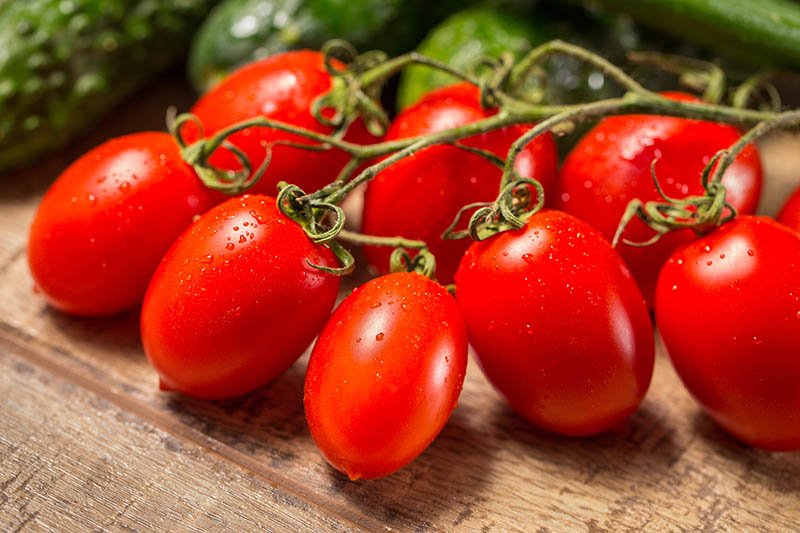With their distinctive oblong shape and meaty flesh, Roma tomatoes are a kitchen staple perfect for sauces, salsas, and more. Their thick walls and few seeds make them ideal for cooking down. But what exactly does a Roma tomato look like? Here is a photo guide to help identify and recognize this versatile tomato variety.
Typical Characteristics of Roma Tomatoes
Roma tomatoes can be easily recognized by their signature elongated, oval shape. Unlike round slicing tomatoes, Roma varieties tend to be more oblong and cylindrical. Here are some of their defining visual features:
-
Elongated oval shape – Length often 2-3 times longer than width, with straight sides
-
Firm and meaty – Thick walls with few seeds make them ideal for cooking
-
Deep red color – Ripe Romas have a deep crimson red hue. Green when unripe.
-
Ridged shoulders – Indented vertical ridges run from stem to blossom end.
-
Pointed tips – The blossom end tapers to a blunt point.
-
Size – Typically 3-6 ounces and 3-5 inches long when mature.
-
Clusters – Grow well in clusters on vines.
Roma Tomato Pictures
Below are pictures of Roma tomatoes at various stages from unripe to fully ripe:
![Green unripe Roma tomatoes on vine][]
Unripe green Roma tomatoes growing on vine![Ripening Roma tomatoes changing color][]
Roma tomatoes ripening on vine, changing from green to red ![Red ripe Roma tomatoes sliced open][]
Sliced open red ripe Roma tomatoes![Bowl of red Roma tomatoes][]
Bowl filled with ripe red Roma tomatoes![Roma tomatoes on vine ripening][]
Close up of Roma tomatoes ripening on the vine
Roma Tomatoes at Different Stages of Ripeness
Roma tomatoes go through distinct color changes as they ripen:
- Green – Unripe Romas are green when young and immature.
- Green-orange – As they start ripening, Romas transition to a greenish-orange hue.
- Red-orange – The tomatoes turn red-orange as they near full ripeness.
- Deep red – Fully ripe Romas are a rich, deep crimson red.
So darker shades of red indicate a riper, sweeter Roma tomato ready for eating or cooking.
Tips for Picking Peak Ripe Roma Tomatoes
Follow these tips for harvesting Romas at optimal ripeness:
- Wait for full red color to develop.
- Choose firm, heavy tomatoes without bruises or soft spots.
- Look for smooth, shiny skin without wrinkles.
- Avoid tomatoes with green shoulders or stem end.
- Pick tomatoes with pronounced ridges and pointed ends.
- Leave vine-ripened tomatoes on bush until deep red.
- Harvest promptly once fully ripe.
With their unique elongated shape and meaty texture, Roma tomatoes are easy to identify in photos once you know what to look for. Use this visual guide to spot perfect peak-ripe Romas for all your cooking needs!
Tomatoes: Round vs Roma — What’s the Difference?
How many Roma tomato plant stock photos are there?
Browse 493 authentic roma tomato plant stock photos, high-res images, and pictures, or explore additional roma tomato field or roma tomatoes stock images to find the right photo at the right size and resolution for your project.
What is a Roma tomato?
You may see ‘Roma’ referred to as Italian or Italian plum tomato, and the name is commonly used as a generic term to describe a paste tomato. An early variety, ‘Roma VF,’ was bred in 1963 for its resistance to both verticillium and fusarium wilt.
Where are Roma tomatoes grown?
Roma tomatoes are grown in the United States, Mexico, Australia, and Great Britain. The ” Roma VF ” variant is most common in seed catalogs as of 2007. It was developed by the USDA ‘s Agricultural Research Service (ARS) scientists in Beltsville, Maryland in the 1950s as a fusarium wilt -resistant cultivar.
Is Roma an heirloom tomato?
While Roma is an open-pollinated variety, in general it is not considered an heirloom tomato . Maturing in under three months, the plant itself grows to 1 metre (39 inches) in height and the single fruit weighs about 60 grams (2.1 ounces). The vines fruit heavily, making Roma a popular variety with gardeners who do a lot of home canning .
- The Ultimate Guide to Growing Strawberries in Raised Beds - August 8, 2025
- No-Dig Garden Beds: The Easiest Way to Grow a Beautiful Garden - August 6, 2025
- How to Protect and Preserve Wood for Raised Garden Beds - August 6, 2025

